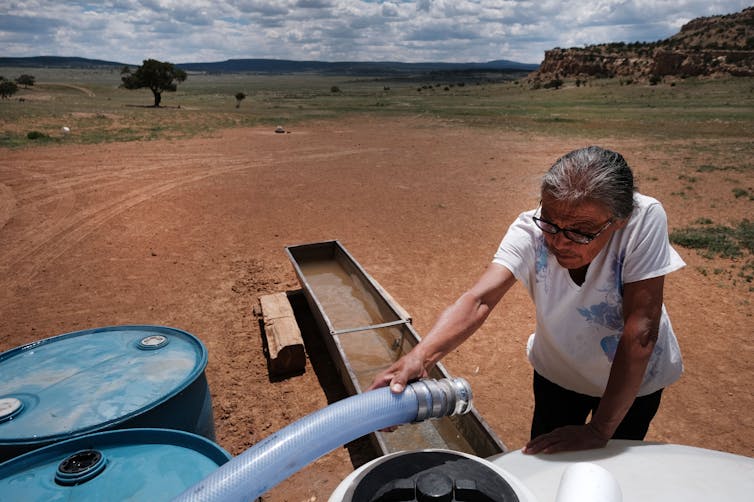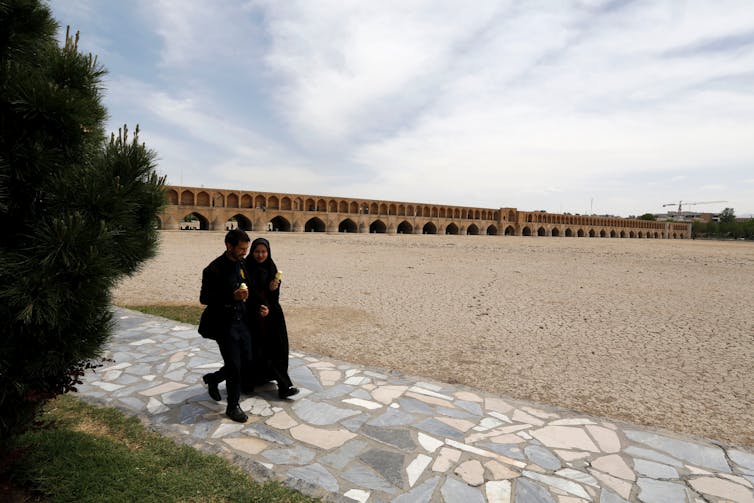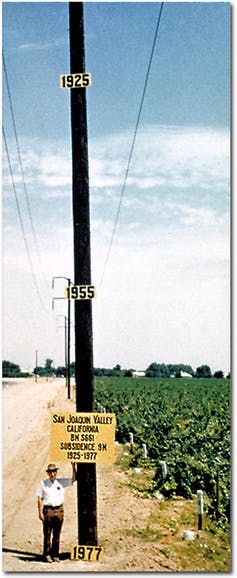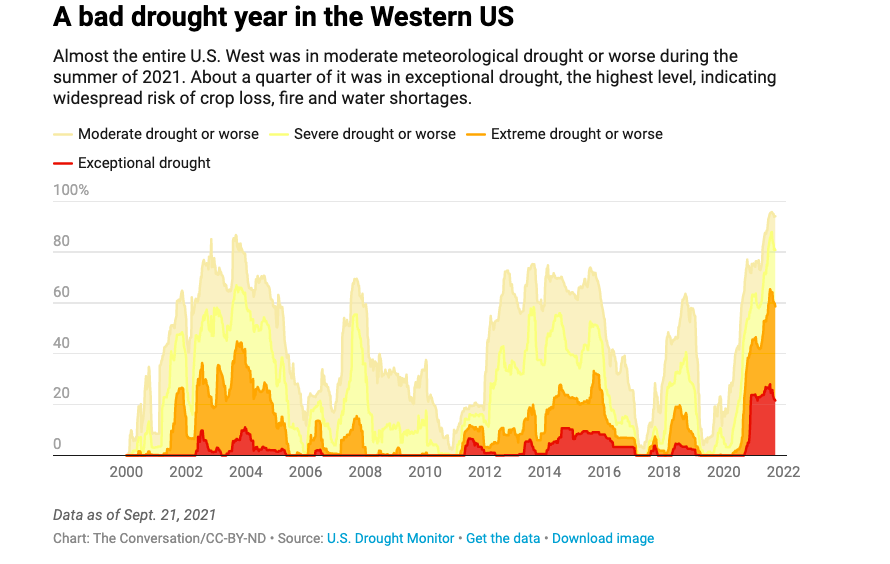
Spencer Platt/Getty Images
Mojtaba Sadegh, Boise State University; Ali Mirchi, Oklahoma State University; Amir AghaKouchak, University of California, Irvine, and Kaveh Madani, Yale University
The 2021 water year ends on Sept. 30, and it was another hot, dry year in the western U.S., with almost the entire region in drought. Reservoirs vital for farms, communities and hydropower have fallen to dangerous lows.
The biggest blow came in August, when the U.S. government issued its first ever water shortage declaration for the Colorado River, triggering water use restrictions.
In response, farmers and cities across the Southwest are now finding new, often unsustainable ways to meet their future water needs. Las Vegas opened a lower-elevation tunnel to Lake Mead, a Colorado River reservoir where water levels reached unprecedented lows at 35% of capacity. Farmers are ratcheting up groundwater pumping. Officials in Arizona, which will lose nearly one-fifth of its river water allotment under the new restrictions, even floated the idea of piping water hundreds of miles from the Mississippi River.
These strategies conceal a more fundamental problem: the unchecked growth of water consumption. The Southwest is in an “anthropogenic drought” created by the combination of natural water variability, climate change and human activities that continuously widen the water supply-demand gap.
In the long run, this can lead to “water bankruptcy,” meaning water demand invariably exceeds the supply. Trying to manage this by cranking up water supply is destined to fail.

More than 7,000 miles away, Iran is grappling with water problems that are similar to the U.S. Southwest’s but more severe. One of the driest years in the past five decades, on the back of several decades of mismanaged water resources, brought warnings of water conflicts between Iranian provinces this year.
As environmental engineers and scientists – one of us is also a former deputy head of Iran’s Department of Environment – we’ve closely studied the water challenges in both drought-prone regions. We believe past mistakes in the U.S. and Iran offer important lessons for future plans in the U.S. Southwest and other regions increasingly experiencing drought and water shortages.
Groundwater pumping: A temporary fix with consequences
As the supply of water from the Colorado River diminishes, Southwest farmers are putting more straws into already declining groundwater that accumulated over thousands to millions of years. But that is a short-term, unsustainable solution that has been tried across the U.S. and around the globe – with major consequences. The High Plains Aquifer and California’s Central Valley are just two examples.
Iran offers a case study in what can go wrong with that approach, as our research shows. The country nearly doubled its groundwater extraction points between 2002 and 2015 in an attempt to support a growing agricultural industry, which drained aquifers to depletion. As its water tables drastically declined, the groundwater’s salinity increased in aquifers to levels that may no longer be readily suitable for agriculture.
As water-filled pores in the soil are drained, the weight of the overlying ground compresses them, causing the aquifers to lose their water holding capacity and accelerating land subsidence. Iran’s capital, Tehran, with more than 13 million residents, subsided more than 12 feet between 2003 and 2017. Similarly, some areas of California are sinking at a rate of up to 1 foot each year.
Interbasin water transfer: A Pandora’s box
Another proposal in the Southwest has been to pipe in water from elsewhere. In May, the Arizona legislature urged Congress to initiate a feasibility study to bring Mississippi River water to replenish the Colorado River. But that, too, has been tried.
In Iran, multiple interbasin water transfer projects doubled the flow of the Zayandeh Rud, a river in the arid central part of the country. The inflow of water supported unsustainable growth, creating demand without enough water to support it. In dry years now, no one has enough water. Many people in Khuzestan – the region supplying water to central Iran – lost their livelihood as their farms dried out, wetlands vanished, and livestock died of thirst. People in central Iran also lost crops to the drought as incoming water was cut. Both regions saw protests turn violent this year.

Atta Kenare/AFP via Getty Images
California diverted water from the Eastern Sierra Nevada to support Los Angeles’ growth in the early 1900s, turning the once prosperous Owens Lake Valley into a dust bowl. Costs of mitigating dust storms there now exceed US$2 billion. Meanwhile, California needs more infrastructure and investment to meet its water demand.
Another project, the California Aqueduct, was constructed in the 1960s to transfer water from the Sacramento-San Joaquin Delta in Northern California to the Central Valley and southern parts of the state to support agriculture and some urban demand. This also did not close the water demand-supply gap, and it pushed economically and culturally important native fish species and ecological systems in the delta to the point of collapse.
Looking ahead in light of looming water bankruptcy
As the continued influx of population into the U.S. Southwest raises water demand in the face of shrinking water supply, we have to wonder whether the Southwest is heading toward water bankruptcy.
While there is no easy solution, a number of actions are possible.
First, recognize that water shortages cannot be mitigated only by increasing water supply – it’s also important to manage water demand.

There is great potential for water savings through efficient irrigation and precision agriculture systems, which could keep agriculture viable in the region.
Cities can save water by curbing outdoor water losses and excess water use, such as on ornamental lawns. Californians successfully reduced their water demand by more than 20% between 2015 and 2017 in response to severe drought conditions. Replanting urban landscapes with native drought-tolerant vegetation can help conserve water.
On the supply side, communities can consider nontraditional water sources, water recycling and reuse in all sectors of the economy, and routing runoff and floodwaters to recharge groundwater aquifers.
[Over 110,000 readers rely on The Conversation’s newsletter to understand the world. Sign up today.]
There are also emerging technological solutions that could boost water resources in some regions, including fog water collection, which uses sheets of mesh to capture moisture from fog, and desalination plants that turn seawater and saline groundwater into drinking water. One new desalination plant planned for Huntington Beach, California, is awaiting final approval. Environmental consequences of these measures, however, should be carefully considered.

The Southwest monsoon returned this summer after a record dry previous year and a half in the region, but it wasn’t enough to end the drought there. Forecasts now suggest a high chance that a La Niña pattern will develop over the winter, meaning Southwest is likely in for another drier-than-normal start to 2022.

Iran is already in water bankruptcy, with demand exceeding supply. It will take a lot more than a wet year to alleviate its water shortages.
Mojtaba Sadegh, Assistant Professor of Civil Engineering, Boise State University; Ali Mirchi, Assistant Professor of Water Resources Engineering, Oklahoma State University; Amir AghaKouchak, Professor of Civil & Environmental Engineering, University of California, Irvine, and Kaveh Madani, Visiting Fellow, Yale University
This article is republished from The Conversation under a Creative Commons license. Read the original article.